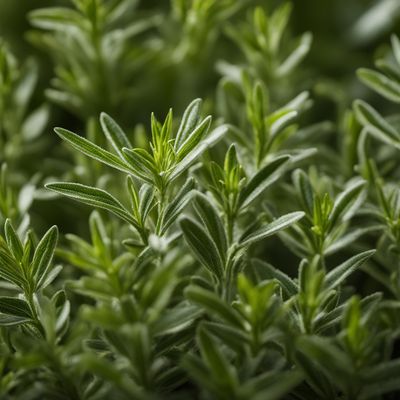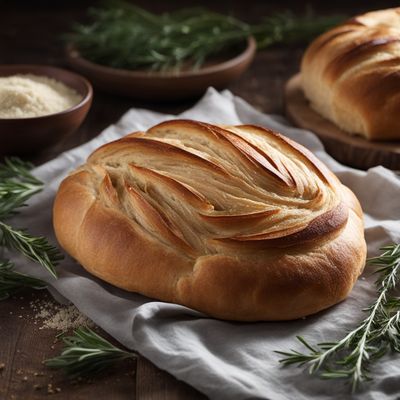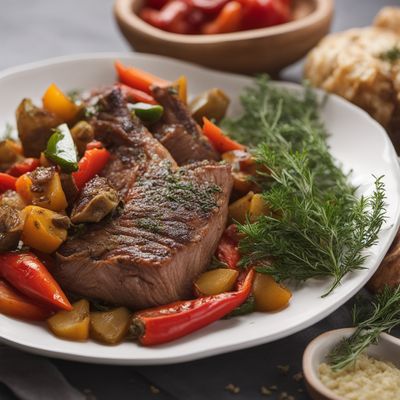
Ingredient
Rosemary, dry
"The Fragrant Herb: Unveiling the Secrets of Dried Rosemary"
Dried rosemary is derived from the fragrant leaves of the Rosmarinus officinalis plant. It is characterized by its needle-like leaves that are dark green on top and silver-gray underneath. The herb has a distinct pine-like fragrance and a robust, slightly bitter taste. The texture of dried rosemary is coarse and brittle, which adds a pleasant crunch when used in cooking. Its appearance adds a touch of elegance to any dish, with its vibrant green color and delicate shape.
Origins and history
Rosemary has a rich history dating back to ancient times. It originated in the Mediterranean region and has been used in culinary and medicinal practices for centuries. The herb holds cultural significance in various cuisines, including Italian, French, and Greek, where it is often associated with prosperity, remembrance, and love.
Nutritional information
Dried rosemary is a good source of dietary fiber, iron, and calcium. It is low in calories, with approximately 2 calories per teaspoon.
Allergens
There are no known allergens associated with dried rosemary.
How to select
When selecting dried rosemary, look for vibrant green leaves that are free from discoloration or signs of moisture. Opt for whole leaves rather than crushed or powdered versions to ensure maximum flavor and freshness.
Storage recommendations
To maintain the freshness and quality of dried rosemary, store it in an airtight container in a cool, dark place away from direct sunlight. Properly stored, dried rosemary can retain its flavor for up to six months.
How to produce
Dried rosemary can be easily produced by air-drying fresh rosemary sprigs. Simply tie the sprigs together and hang them upside down in a well-ventilated area until they are completely dry. Once dry, remove the leaves from the stems and store them in an airtight container.
Preparation tips
Before using dried rosemary, it is recommended to crush or grind the leaves to release their full flavor. This can be done using a mortar and pestle or a spice grinder. Dried rosemary is a versatile herb that can be used in marinades, rubs, soups, stews, roasted meats, and vegetables. It pairs well with garlic, lemon, thyme, and olive oil. Remember to use dried rosemary sparingly, as its flavor can be intense.
Substitutions
If dried rosemary is not available, you can substitute it with dried thyme or dried oregano, which offer similar earthy and aromatic notes.
Culinary uses
Dried rosemary is commonly used in Mediterranean cuisine, particularly in dishes like roasted lamb, grilled vegetables, tomato-based sauces, and bread. It is also a popular addition to herb-infused oils and vinegars. Its versatility allows it to enhance the flavors of both savory and sweet dishes, such as roasted potatoes, focaccia bread, and lemon-infused desserts.
Availability
Dried rosemary is widely available in grocery stores, supermarkets, and online retailers worldwide.
More ingredients from this category » Browse all

Marjoram, dry
Discovering the Aromatic Delights of Dry Marjoram

Woodruff, dry
The Fragrant Herb: Unveiling the Secrets of Dry Woodruff

Fennel, dry
The Fragrant Spice of the Mediterranean

Sage, dry
The Timeless Herb: Unveiling the Versatility of Dry Sage

Basil, dry
The Fragrant Herb: Dried Basil

Lavender, dry
The Fragrant Herb: Lavender

Bay leaves, dry
Aromatic Leaf of Flavor

Savory, dry
Umami Delight

Angelica, dry
The Heavenly Herb: Unveiling the Secrets of Dry Angelica

Wintergreen leaves, dry
Nature's Minty Delight

Sweet cicely, dry
The Delicate Herb: Sweet Cicely

Hyssop, dry
The Aromatic Herb: Unveiling the Secrets of Dry Hyssop
Recipes using Rosemary, dry » Browse all

Varaždinski Mlinci with Roasted Chicken
Savory Croatian Delight: Roasted Chicken with Varaždinski Mlinci

New Zealand-inspired Weekend Pizza
Kiwi Delight Pizza: A Fusion of Norwegian and New Zealand Flavors

Zuppa alla Ueca with a Twist
Savory Italian Vegetable Soup with a Burst of Flavor

German-style Stuffed Pork Roast
Savory Delight: German-inspired Stuffed Pork Roast

Cebularz Lubelski - Onion Bread from Lublin
Savory Onion Delight: Cebularz Lubelski Recipe

Rag Pudding with a Twist
Savory Delight: A Modern Twist on Traditional British Rag Pudding

Acquacotta - Tuscan Vegetable Soup
Soul-Warming Tuscan Delight: Acquacotta - A Hearty Vegetable Soup

Conger Bread with a Twist
Savory Seafood Delight: Conger Bread with a Flavorful Twist

Croatian Peka with Tender Lamb and Vegetables
Savor the Flavors of Croatia: Slow-Cooked Lamb Peka

Baked Chicken Breast with Italian Herbs
Herb-Infused Baked Chicken Delight

Kotlovina - Croatian Grilled Meat Stew
Flavors of the Croatian Countryside: Grilled Meat Stew

Huckabuck Delight
Savory Delights: A Twist on the Classic Huckabuck